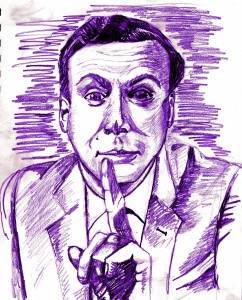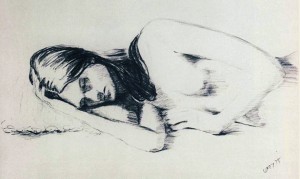MONDAY, 4 JANUARY 2010
We often learn little more about scientists than their name and the value of the constant they defined: Boltzmann, Avogadro, Planck. We are forced to generate our own ideas about scientists’ personalities with little basis. People are drawn to a stereotype of successful scientists that alienates them and places them in a different sphere, removed entirely from ‘the real world’. We imagine a man in his own intellectual bubble; wild hair, lab coat and jam-jar-bottomed glasses askew. He’s happy to spend his time alone, scrawling chalk over blackboard walls. Because that’s how you get science done, right? Wrong.On May 11, 1918, in a small suburb of New York named Far Rockingham, Richard Phillips Feynman was born. He showed academic flair from a young age, begging his teachers to explain concepts that were far too advanced for his peers. He set up a lab in his bedroom, and became renowned in his neighbourhood for fixing radio circuitry. During his teenage years, he devised his own notations to replace the standard for inverse trigonometric functions, which the young Feynman thought were “crazy”. Clearly, this was no ordinary childhood.
But it is a unique approach to life that makes a great scientist. Feynman was clearly gifted in his ability to analyse and interpret the physical world, but what truly set him apart was a desire to know; he sought The Pleasure of Finding Things Out (later the title of his book about the Manhattan Project). This almost childish curiosity remained with Feynman for the rest of his life. Combining this with blistering intelligence and an eye for adventure, Richard Feynman’s life was set to be one of the most incredible of the 20th century.
During his career, Feynman worked on the atomic bomb, was instrumental in the investigation into the Challenger shuttle disaster and ultimately won the Nobel Prize for his contributions to the rapidly developing field of quantum mechanics. Even though these academic achievements were what led to his eminence, they were merely one facet of Feynman’s multidimensional world.
Excitement and adventure pursued Feynman throughout his life, though he did not actively seek them. His enquiring mind and deep thirst for knowledge (and a keen interest in the opposite sex) often led him down strange and incredible paths that were far from academic. When he and his friend were asked back to a hotel by two mysterious women, his friend cried, “What do they want us to go there for?” Feynman replied, “Hell, I don’t know. But I don’t have to know. It’s just fun, seeing what’s going to happen; it’s an adventure.” Feynman went with them, alone, and found himself at the party of a society for the deaf. Feynman was fascinated by the way the deaf communicated and, like many of his escapades, this led the young scientist to learn a new skill: sign language.
Feynman amassed a formidable range of skills in his lifetime – from life drawing to juggling to bongo drumming. He acted in student plays, performed in Brazilian street festivals and even turned his hand to deciphering Mayan hieroglyphics, making considerable advances in the field. In whatever direction Feynman turned his razor-sharp intelligence, he succeeded. And every skill was accompanied by an incredible story about its acquisition.
However, there was one area where things weren’t so immediately easy. As an undergraduate at MIT, Feynman explained what he described as “the hard stuff” to less academic students in return for advice on how to deal with girls. He felt awkward around them, but this just presented a new puzzle that, unsurprisingly, he overcame. Soon it became just another of his talents; “The only thing in Las Vegas that was fun was meeting showgirls.” Later, he used a strip club as an office, scrawling his equations on beer mats. One evening, when Feynman was chatting to the Master of Ceremonies at the club, the man told him never to buy a girl a drink until he had made sure, by asking, that she would sleep with him first. Feynman tested this once – successfully – but concluded it was more fun to adopt a more traditional approach.
In later life, Feynman became a renowned teacher. The series of undergraduate lectures he gave at The California Institute of Technology (CalTech) between 1961 and 1963 have become legendary in the physics community. His exuberant style provided more than education; it was entertainment. As a result, CalTech physics undergraduates found their lectures crowded with students of other subjects, who had come to see a master at work. The lecture series became a set of books that are still an essential part of a physics student’s library.
Feynman’s unique personality was perhaps best exemplified while he was working on the atomic bomb at Los Alamos during the 1940s. Extremely sensitive military secrets, such as blueprints and information about radioactivity, were held in safes; “These new filing cabinets were an immediate challenge, naturally. I love puzzles.” Feynman worked hard at understanding the locks, going so far as to take apart his own, and spent hours practising the safe-cracking techniques he had developed himself.
He realised that the big safes, where the really important secrets were kept, had the same mechanism as the little ones in the offices, even though they looked more impressive. He opened some with no difficulty, nonchalantly picking the lock on mankind’s biggest secrets. Unfazed, and showing his passion for mischief, he left anonymous notes inside. He hung around to watch the warden go pale when he returned and found the messages. After leaving the warden to stew for a while, Feynman told him what had happened, with fear that he would be angry. Instead, he took Feynman in a delighted embrace because he was so relieved that the military secrets hadn’t been leaked.
In the semi-autobiographical book Surely You’re Joking, Mr Feynman!, Feynman’s astounding array of stories are recounted verbatim from recorded conversations he had with friend and film producer Ralph Leighton whilst they played bongos together. Feynman’s writing style is endearing; his childlike approach to life can seem naïve, but when one takes into account his incredible achievements, it seems difficult to argue with. What is most striking, both in his writing and in the accounts of his friends and family, is that Feynman never displayed a hint of arrogance. Instead, there is a constant air of bemusement at the high esteem in which others held him. It seems clear through his narrative that Feynman’s genius was so intrinsic to his being that he missed it completely.
All scientists can learn something from Feynman: to always approach science with passion, drive and vigour. Never be afraid to pursue a line of enquiry, even if it is for no more reason than interest, and never get down-hearted if you fail to understand something. Constantly seek to look at the same things in different ways, and maintain a clear mind at all times. For most of us, these things don’t come as easily, but at least we know what we’re aiming for.
Feynman died of cancer in 1988 – “I’d hate to die twice, it’s so boring” – but had left his mark on physics, and the world, forever. While his enthusiasm for life was universal, Feynman’s first love was always science, to which his work was an everlasting gift. His genius was summarised by fellow Nobel laureate Hans Bethe; “There are two types of genius. Ordinary geniuses do great things, but they leave you room to believe that you could do the same if only you worked hard enough. Then there are magicians, and you can have no idea how they do it. Feynman was a magician.”
Jake Harris is a first year Natural Sciences Tripos student



